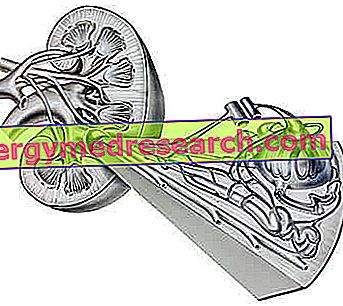Generality
The glomerular filtration rate (eGFR) is an indicator of the health status of the kidneys.

EGFR can be determined at the same time as the blood sample is taken for creatinine measurement.
What is creatinine
Creatinine is a substance produced by the muscles and eliminated by the kidneys: its level in the blood increases when renal function decreases.
What's this
eGFR (acronym for " Estimated Glomerular Filtration Rate ") indicates the glomerular filtration rate, ie the rate at which blood is filtered (and cleaned) by the kidneys.
In practice, this parameter is an indicator of the state of renal health, and simply serves to assess whether the functionality of these organs is good or is compromised.
At the kidney level, the glomeruli are comparable to small filters that allow the removal of waste products from the blood, preventing the loss of important constituents, including proteins and blood cells. The kidneys filter about 200 liters of blood daily and produce 2 liters of urine.
The glomerular filtration rate (GFR) refers to the amount of blood that is filtered by the glomeruli per minute. If the kidney function of the individual decreases in relation to a damage or a pathology, the speed of filtration decreases and the waste products start to accumulate in the circulatory stream.
Why do you measure
- The glomerular filtration rate is based on the measurement of creatinine concentration in the blood ( creatininemia ), the result of which is inserted into a formula. The latter allows to calculate a number, called the estimated GFR or eGFR, which indicates the quality of renal functioning.
- The eGFR is calculated to identify possible renal damage or to monitor the function of the kidneys in the course of diseases that may involve them (for example: diabetes, hypertension or various acute or chronic renal diseases). Usually, this exam is combined with creatinine, azotemia and cystatin C assessments.
- Furthermore, determining the glomerular filtration rate can help the doctor understand the extent of kidney disease and plan the best treatment.
When is it prescribed?
The calculation of the glomerular filtration rate is performed automatically, each time the creatinine is dosed.
EGFR can be prescribed when the doctor wishes to assess kidney function, as part of the general check-up of the patient. The glomerular filtration rate can also be determined in cases where the presence of a renal disease is suspected.
The eGFR measurement is performed, without the use of other tests, at the same time as the blood sample is taken for the determination of creatinine. This last test is frequently requested as part of the metabolic panel (complete or basic) or together with azotemia, whenever the doctor wants to evaluate the health status of the patient's kidneys.
The glomerular filtration rate is measured regularly in the presence of a chronic kidney disease or in patients with diabetes, hypertension and other conditions that can cause kidney damage.
Renal pathology: alarm bells
Chronic nephropathies are associated with an often progressive decrease in renal function. Early detection of this condition can help minimize the damage.
Symptoms do not manifest themselves before 30-40% of kidney function is lost. These include:
- Swelling, especially around the eyes, wrists, abdomen or ankles;
- Foamy urine, with traces of blood or coffee-colored;
- Urine volume reduction;
- Difficulty urinating, burning sensation or abnormal jet during urination;
- Back pain, under the rib cage, near the kidneys;
- High blood pressure (hypertension);
If nephropathy worsens and renal function is diminished, disorders can result in the impairment of various organs and systems:
- Changes in voiding frequency, especially at night;
- Lack of breath;
- Itch;
- Drowsiness, attention disorders and loss of concentration;
- Fatigue without apparent cause;
- Gastrointestinal disorders, such as loss of appetite, unusual weight loss, nausea and / or vomiting;
- Swelling and / or tingling in hands and feet;
- Muscle cramps.
Normal values
The normal values of eGFR vary according to the age of the subject.
In general, the reference interval must be between 90-120 ml / min. The lower the value, the greater the risk of incurring renal damage.
When are GFR values considered at risk?
The eGFR values can indicate both the risk and the renal damage.
- ≥ 90 ml / min: mild renal damage, but with normal function;
- 89 - 60 ml / min: damage with minimal loss of renal function;
- 59 - 44 ml / min: mild to moderate loss of renal function;
- 44 - 30 ml / min: moderate to severe loss of renal function;
- 29 - 15 ml / min: severe loss of renal function;
- <15 ml / min: renal failure.
eGFR Alta - Cause
If the values resulting from the eGFR examination were to exceed 90 ml / min, normal kidney function occurs. However, when the glomerular filtration rate is excessively high, there is the possibility of being at risk of developing diseases such as hypertension.
eGFR Low - Causes
Too low an eGFR index may indicate kidney failure, which is the inability of the kidneys to perform their functions appropriately. This is the worst condition that can result from examining the glomerular filtration rate.
How to measure it
eGFR is a calculated estimate of the glomerular filtration rate. This is based on the concentration of creatinine in the blood, along with other variables that can include age, patient sex and ethnicity, as well as height and weight in kg, in relation to the equation used.
Creatinine levels can be detected both in the blood (when it is a routine check), and in urine (if a more reliable assessment of renal function is needed).
In the first case, it is sufficient to take a blood sample from the vein of one arm (fasting and resting for at least 8 hours), while in the second the test is performed on a urine sample collected within 24 hours.
EGFR calculation formula
Considering that the direct measurement of the glomerular filtration rate is quite difficult, since it requires highly qualified personnel in specialized laboratories, eGFR is usually obtained with a specific predictive equation starting from creatininemia (value of serum creatinine).
The three main formulas used to calculate the glomerular filtration rate are:
- Cokroft-Gault formula ;
- Formula MDRD (acronym that stands for " Modification of Diet in Renal Disease ");
- CKD-EPI formula (acronym that stands for " Chronic Kidney Disease Epidemiology Collaboration ") - currently the most used and the most precise for this type of calculation.
What are the factors that can influence the results?
All the above formulas have precision limits when applied to particular categories of patients, including pregnant women (note: gestation contributes to an increase in GFR), obese people or those with a lot of muscle mass (as the body produces creatinine based on its volume).
Among the factors that can influence the calculation of the eGFR we also find:
- Amount of protein in the diet;
- Extreme age limits (75 years);
- Amount of proteins present in the individual's diet;
- Drugs: may contribute to an increase in eGFR, especially drugs like gentamicin or some cephalosporins;
- Some pathologies: diseases that interfere with the functioning of the kidneys contribute to lowering the level of GFR; the conditions that decrease the blood supply to the organs, on the other hand, increase the concentration of creatinine.
Finally, this type of examination must be performed at a time when creatinine production and kidney function are relatively stable.
Preparation
In the 8-12 hours prior to taking blood useful for measuring the glomerular filtration rate, it is important to avoid intense physical exercise. This activity can, in fact, alter the values of creatinine and, consequently, of the eGFR.
Furthermore, the patient may be required to remain fasting the night before the withdrawal or to refrain from eating meat.
Interpretation of Results
The glomerular filtration rate helps determine early-stage kidney damage, more reliably than with creatinine alone.
A patient's eGFR should be interpreted in relation to the patient's medical history and the pathologies from which it is affected, using the following table:
| Stage of renal damage | eGFR | Other tests | |
| 1 | Minimal renal damage or normal function with normal eGFR | 90+ | Proteins or albumin in the urine are high, cells or cylinders in the urine |
| 2 | Poor decrease in eGFR | 60-89 | Proteins or albumin in the urine are high, cells or cylinders in the urine |
| 3 | Moderate decrease of eGFR | 30-59 | |
| 4 | Serious decrease of eGFR | 15-29 | |
| 5 | Renal dysfunction | <15 | |



